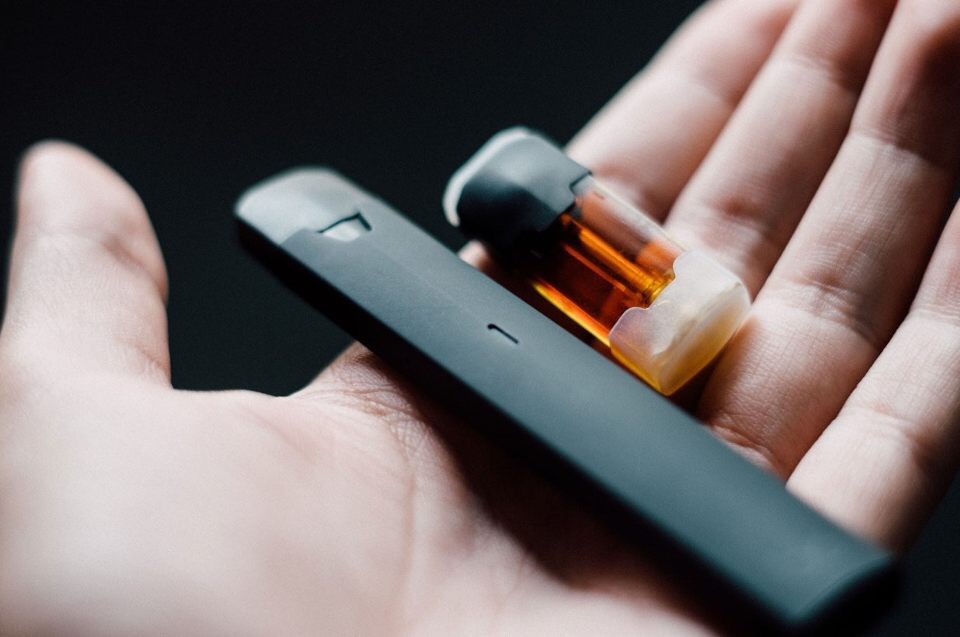
Christian is a senior here at St. Dominic. He is the secretary of the Ambassadors Program and involved in National Honors Society, Peer Ministry and Pro-Life...

September 13, 2019
In the past few years, the use of e-cigarettes and vapes among teens has increased at an alarming rate. What started out as a popular trend has turned into a nationwide epidemic.
On August 30, the Centers for Disease Control and Prevention (CDC) issued “a multistate outbreak of severe pulmonary disease” with 215 severe lung illness cases across 25 states, thought to be connected to e-cigarette use. Symptoms included coughing, chest pain, diarrhea, vomiting, shortness of breath and fever.
“Based on clinical and laboratory evidence to date, we believe that a chemical exposure is likely associated with these illnesses. However, and I really want to stress this, more information is needed to determine which specific products or substances are involved,” Dr. Dana Meaney-Delman said.
As part of their investigations, state health officials have sent product samples to the Food and Drug Administration (FDA) for analysis. The FDA is evaluating for THC (high-inducing compound in marijuana), nicotine, Vitamin E, acetate and other chemicals.
Last year, the U.S. Surgeon General’s office began raising awareness after a warning was issued that youth vaping has reached epidemic status. Over 3.6 million middle and high school students currently use e-cigarettes, and many think it is harmless.
What is vaping? To vape is to inhale vapor created from a liquid heated up inside a device. The devices have many names: vape pens, pod mods, tanks, electronic nicotine delivery devices (ENDS), e-hookahs and e-cigarettes. The liquid they contain is often referred to as e-juice, pods or cartridges.
For many high school students, vape culture has become the norm. Seniors will buy supplies and sell them at significantly higher prices to underclassmen. Since freshmen and sophomores have no other resources, they have to pay the hefty price. Many students have an older sibling buy vapes and pods for them, allowing them to avoid the hassle of bothering friends or classmates.
One of the largest concerns with vaping are the unknown long-term effects. Since e-cigarettes have only been on the market for a little over ten years, no one truly knows how vaping every day will affect consumers in 20 years. Many teenagers use the excuse “vapes are safe” because of the lack of known health risks.
Many teens began juuling because of social pressure. Teens feel peer pressure to follow the trend and buy vapes in order to fit in. Social bonds have also formed over vaping; kids will form relationships over a mutual use of vapes. This added social pressure has gotten students addicted to nicotine who may have never touched a vape in the first place.
Many schools and businesses are trying to crack down on minors vaping. JUUL, the most popular type of vape on the market, has pulled fruity, more appealing flavors like mango off the market to drive away minors. Schools are now considering the use of vapes equivalent to alcohol or marijuana use.
Fortunately, the government is starting to step in while the crisis continues. As severe health issues begin to plague e-cigarette users, we encourage all teens to stay safe and make good decisions.
Sources:
After several mysterious vape-related illnesses, the Trump administration is trying to take a stand against e-cigarettes.
On September 11, the Trump administration said it would ban the sale of most flavored e-cigarettes, after hundreds of people have become sick as lung illnesses and teenage vaping continues to rise.
President Trump acknowledges there is an epidemic. The health and human services secretary, Alex M. Azar II, says the FDA would outline a plan removing flavored e-cigarettes and pods from the market. The ban would include mint and menthol, popular types of pods that manufacturers argue should not be considered flavors, and therefore allowed on markets.
The government has faced rising pressure from lawmakers, public health officials, parents and many others who are alarmed by the popularity of vaping among teens. With about 500 cases in over 30 states and six possible linked deaths, concerns and demands for a total ban of e-cigarette and cannabis vaping products have become louder and more numerous. In early September, Michigan became the first state to prohibit the sale of flavored vapes, with several states currently talking about following their lead.
Last year, the FDA began to feel pressure to prohibit e-cigarettes. The public began to accuse Juul Labs of deliberately targeting youth with the sale of flavored pods, such as mango and cucumber. The result was Juul Labs pulling back the shipping of these pods to thousands of retail locations across the U.S.
In a recent survey, five million minors, mostly high schoolers, reported they had recently used e-cigarettes. About one-fourth of the nation’s high school students reported vaping in the last 30 days, up 20 percent from last year.
“What we’ve seen has been, and it may be connected, a huge spiking of children’s utilization of mint and menthol e-cigarettes, which remain, by all manufacturers, available in retail stores,” Azar said.
Matthew L. Myers, president of the Campaign for Tobacco-Free Kids, called the administration’s decision “historic.”
“President Trump’s announcement that the government will remove flavored e-cigarettes from the market is an extraordinary and necessary step. This is a public health crisis, and we cannot afford more delays in confronting it,” Myers said.
Harold Wimmer, president and chief executive of the American Lung Association, said the group had long advocated removal of products that appealed to teenagers.
“Flavors have been shown to initiate kids to tobacco use and a lifetime of addiction and tobacco-related death and disease. We are anxious to review all of the details of the administration’s plan,” Wimmer said.
The Centers for Disease Control and Prevention have urged people, especially nonsmokers and teenagers, not to vape at all. And the C.D.C. has even recommended that cigarette smokers trying to quit should consult a doctor rather than take up e-cigarettes.
Although the Trump Administration has not put anything into effect quite yet, the United States should expect to see changes to vaping both in state and nationwide laws.
Source: https://www.nytimes.com/2019/09/11/health/trump-vaping.html

Christian is a senior here at St. Dominic. He is the secretary of the Ambassadors Program and involved in National Honors Society, Peer Ministry and Pro-Life...